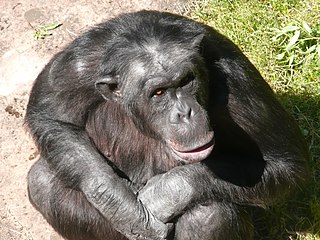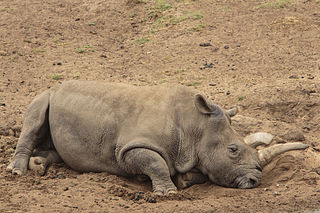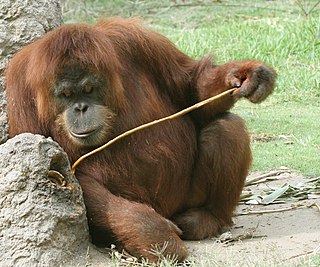
Orangutans are great apes native to the rainforests of Indonesia and Malaysia. They are now found only in parts of Borneo and Sumatra, but during the Pleistocene they ranged throughout Southeast Asia and South China. Classified in the genus Pongo, orangutans were originally considered to be one species. From 1996, they were divided into two species: the Bornean orangutan and the Sumatran orangutan. A third species, the Tapanuli orangutan, was identified definitively in 2017. The orangutans are the only surviving species of the subfamily Ponginae, which diverged genetically from the other hominids between 19.3 and 15.7 million years ago.

The San Diego Zoo is a zoo in San Diego, California, located in Balboa Park. It began with a collection of animals left over from the 1915 Panama–California Exposition that were brought together by its founder, Dr. Harry M. Wegeforth. The zoo was a pioneer in the concept of open-air, cage-less exhibits that recreate natural animal habitats.

The San Francisco Zoo is a 100-acre (40 ha) zoo located in the southwestern corner of San Francisco, California, between Lake Merced and the Pacific Ocean along the Great Highway. The zoo's main entrance is to the west, on the ocean side. The SF Zoo is owned by the San Francisco Recreation & Parks Department, and managed by the San Francisco Zoological Society, a non-profit 501(c)(3) organization. under a public-private partnership since 1993, receives $4.2 million annually from the city. As of 2016, the zoo housed more than one thousand individual animals, representing more than 250 species. It is noted as the birthplace of Koko the gorilla, and, from 1974 to 2016, the home of Elly, the oldest black rhinoceros in North America.
Chantek, born at the Yerkes National Primate Research Center in Atlanta, Georgia, was a male hybrid Sumatran/Bornean orangutan who demonstrated a number of intellectual skills, including the use of several signs adapted from American Sign Language (ASL). American anthropologists Lyn Miles and Ann Southcombe worked with Chantek. In 1997, he was transferred to Zoo Atlanta, where he lived for another twenty years.

Adelaide Zoo is a zoo in Adelaide, Australia. It is the country's second oldest zoo opening in 1883, and is operated on a non-profit basis. It is located in the parklands just north of the city centre of Adelaide, South Australia. It is administered by the Royal Zoological Society of South Australia Incorporated, which is a full institutional member of the Zoo and Aquarium Association and the World Association of Zoos and Aquariums, and which also administers the Monarto Safari Park near Murray Bridge.

The Aktiengesellschaft Cologne Zoological Garden is the zoo of Cologne, Germany. Being the third oldest zoo in Germany, it features over 10,000 animals of more than 850 species on more than 20 hectares. The internationally renowned zoo with an attached aquarium and invertebrate exhibit is active in preservational breeding of animals that are in danger of becoming extinct. In addition, in-the-wild conservation efforts and research focussing on animals of Madagascar, Wallacea, and Vietnam are actively promoted and supported via cooperation with Cologne University and local projects, such as in the case of Przewalski's horses.

The Southern Nevada Zoological-Botanical Park, informally known as the Las Vegas Zoo, was a 3-acre (1.2 ha), nonprofit zoo and botanical garden located in Las Vegas, Nevada that operated from 1981 to September 20, 2013. It was located northwest of the Las Vegas Strip, about 15 minutes away. It focused primarily on the education of desert life and habitat protection. Its mission statement was to "educate and entertain the public by displaying a variety of plants and animals". An admission fee was charged. The park included a small gem exhibit area and a small gift shop at the main exit. The gift shop and admission fees helped support the zoo.

The Topeka Zoo is a medium-sized zoo in Topeka, Kansas in the United States. It is located within Gage Park, just off I-70 in the north central portion of the city. Despite its size, it houses over 300 animals in a number of exhibits, including one of the first indoor tropical rain forests in the United States. It is one of the most popular attractions in Topeka, with over 250,000 visitors a year.
The Zoo was a New Zealand observational documentary series, made by Greenstone TV, that followed the lives of Auckland Zoo's animals and zookeepers. The series explored the new arrivals and births of Auckland Zoo, to the fights, illnesses and mating rituals, how the animals are fed and how they live. The series' production crew were based full-time at the zoo, but the series also followed zookeepers overseas on zoo-related trips.

Seoul Grand Park (Korean: 서울대공원) or Gwacheon Seoul Grand Park (과천서울대공원) is a park complex to the south of Seoul, South Korea, in the city of Gwacheon. Opened on May 1 in 1984.
The Duisburg Zoo, founded on 12 May 1934, is one of the largest zoological gardens in Germany. It is especially well known for its dolphinarium and, since 1994, for breeding koalas.

Utah's Hogle Zoo is a 42-acre (17 ha) Association of Zoos and Aquariums (AZA) and the World Association of Zoos and Aquariums (WAZA) accredited facility. Located at the mouth of Salt Lake City's Emigration Canyon, Hogle Zoo is one of the largest zoos in the Intermountain West, and houses over 800 animals representing 139 species.
Orangutans have often attracted attention in popular culture. They are mentioned extensively in works of fiction and video games, while some captive individuals have drawn much attention in real life.

Two tiger attacks occurred at the San Francisco Zoo, in 2006 and 2007, both involving a female Siberian tiger named Tatiana. In the first incident, a zookeeper was bitten on the arm during a public feeding. In the second incident, one person was killed and two others were injured before police shot and killed Tatiana on the scene.
Ziggy was a male Indian elephant who lived at Brookfield Zoo outside Chicago from 1936 to 1975. He weighed about six tons and was over ten feet tall. After attacking and nearly killing his keeper in 1941, Ziggy was chained to the wall of an indoor enclosure, and remained there for nearly three decades. His confinement became a cause célèbre in the late 1960s, when schoolchildren and other animal enthusiasts began campaigning for his release. Ziggy was briefly allowed to go outside in 1970. One year later, the zoo completed a new specifically designed outdoor facility. Ziggy died in 1975.

Santino was a male chimpanzee held at Furuvik Zoo in Sweden. In March 2009, it was reported that Santino had planned hundreds of stone-throwing attacks on visitors to the zoo.

Nola was a northern white rhinoceros who lived at the San Diego Zoo Safari Park near Escondido, California, United States. At her death, she was one of only four of her subspecies overall. She was outlived by male Sudan and females Najin and Fatu.

Karen is a Sumatran orangutan, who on 27 August 1994 at the San Diego Zoo was the first orangutan to have open heart surgery and in 2021 was among the first non-humans to receive a vaccine for COVID-19.

Karta was a Sumatran orangutan, who is best remembered for her attempts to have a living baby and care for it herself, first at the San Diego Zoo in the United States, and later at Adelaide Zoo in Australia.














